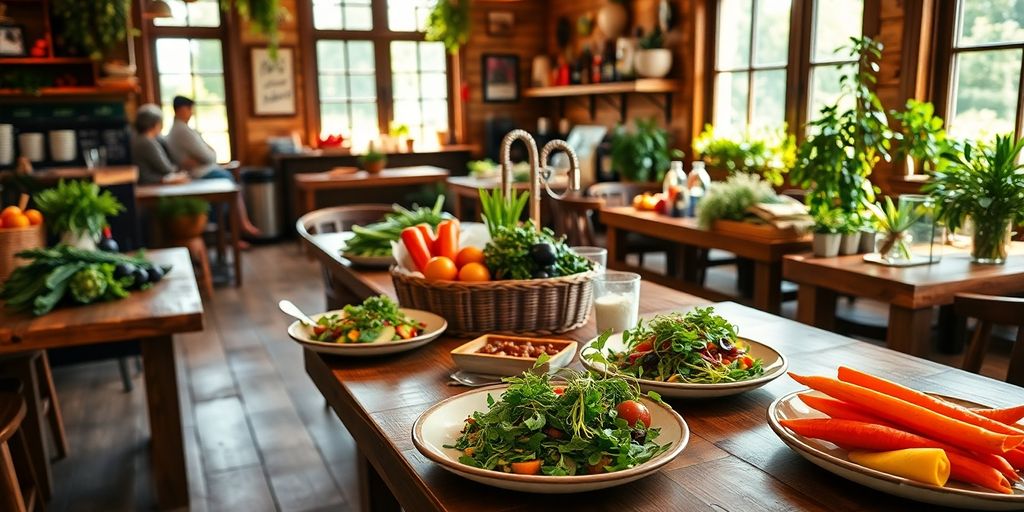SEO is a game-changer for farm-to-table restaurants. These eateries thrive on local customers who value fresh, locally sourced ingredients. But how do you make sure they find you? That’s where SEO comes in. By optimizing your online presence, you can attract more diners, boost your reputation, and ensure your restaurant stands out in a crowded market. Let’s explore how you can use SEO to make your farm-to-table restaurant the go-to spot for local food enthusiasts.
Key Takeaways
- Focus on local SEO to attract nearby customers.
- Engage with your audience through social media and content.
- Use high-quality visuals to showcase your offerings.
- Build a strong backlink profile for better search rankings.
- Regularly update and audit your website for optimal performance.
Understanding Local SEO for Farm-to-Table Restaurants

Importance of Local Keywords
When it comes to farm-to-table restaurants, focusing on local keywords is a game-changer. These keywords help you connect with diners in your area who are searching for fresh, locally-sourced meals. Think about it—people often search for "restaurants near me" or "best organic restaurant in [city]." By sprinkling these phrases throughout your website, you’re more likely to pop up in their search results.
A simple start is to include your city or neighborhood in the website’s content, meta tags, and even in blog posts. This not only helps in search engine rankings but also makes your content more relatable to your local audience.
Optimizing Google Business Profile
Your Google Business Profile is like your online storefront. Keeping it up-to-date is crucial. Make sure all the information is accurate—think hours, address, and contact details. Add some high-quality photos of your dishes and the restaurant itself. This visual appeal can draw in potential customers.
Here’s a quick checklist:
- Verify your business address.
- Update operating hours, especially during holidays.
- Add a link to your menu and website.
Encouraging Customer Reviews
Customer reviews can make or break your online reputation. Encourage your happy diners to leave positive reviews on Google. Not only do these reviews boost your credibility, but they also help with your local SEO.
Consider the following tips:
- Ask for feedback right after a meal when the experience is fresh.
- Respond to reviews—both good and bad. It shows you care.
- Offer incentives, like a discount on their next visit, for leaving a review.
"Engaging with your customers through reviews not only builds trust but also strengthens your online presence."
By focusing on these local SEO strategies, farm-to-table restaurants can better connect with their community and attract more diners.
Creating Engaging Content for Your Audience
Blogging About Local Ingredients
Blogging is a fantastic way to connect with your audience by sharing stories about the local ingredients that make your dishes special. Dive into the journey of these ingredients from farm to plate. Share insights about the farmers you work with, the challenges they face, and the seasonal changes that affect your menu. This not only educates your readers but also builds a narrative around your restaurant’s commitment to local sourcing.
Highlighting Chef Stories
Your chefs are the heart of your restaurant, each with a unique story to tell. Highlighting their backgrounds, inspirations, and culinary journeys can create a personal connection with your audience. Consider sharing interviews or behind-the-scenes glimpses of their creative process. This approach humanizes your brand and can make your restaurant feel more approachable and relatable.
Sharing Sustainable Practices
Farm-to-table restaurants often pride themselves on sustainability. Share your sustainable practices with your audience, such as how you minimize waste or support eco-friendly farming. Transparency in your operations can build trust and loyalty among diners who are conscious about the environment. Use lists to outline specific practices, like composting, recycling, or using energy-efficient appliances:
- Composting kitchen waste
- Recycling materials
- Using energy-efficient appliances
By openly discussing your sustainable efforts, you not only educate your audience but also inspire others to adopt similar practices. This can enhance your reputation as an environmentally conscious establishment and attract like-minded customers.
Utilizing Social Media for Increased Visibility
Choosing the Right Platforms
Picking the right social media platforms is like choosing the best ingredients for your signature dish. Each platform has its unique flavor and audience. For farm-to-table restaurants, Instagram and Facebook are usually the go-to choices. Instagram’s visual nature lets you showcase your stunning dishes and farm connections, while Facebook offers a more detailed storytelling approach. Knowing where your audience hangs out is key. Don’t spread yourself too thin; focus on platforms where you can consistently engage.
Engaging with Your Community
Social media isn’t just about posting pretty pictures; it’s about building a community. Respond to comments, ask questions, and encourage your followers to share their own farm-to-table experiences. This interaction creates a sense of belonging and makes your restaurant more relatable. Try hosting live Q&A sessions or sharing behind-the-scenes moments to deepen this connection. When people feel like they’re part of your journey, they’re more likely to become loyal customers.
Promoting Events and Specials
Got a new seasonal menu or an upcoming event? Social media is perfect for spreading the word. Create eye-catching posts to announce specials, and don’t forget to use hashtags to increase your reach. Consider running contests or giveaways to generate excitement and engagement. Highlighting events like farm visits or chef’s table nights can also draw attention. Remember, the goal is to create buzz and get people talking about your restaurant.
Social media is your megaphone in the digital world. Use it wisely to amplify your farm-to-table philosophy and connect with those who appreciate the journey from farm to plate.
The Role of Visual Content in SEO
Using High-Quality Images
Images speak volumes, especially in the world of farm-to-table dining. High-quality photos of your dishes can make a significant impact. When customers see vibrant, appetizing pictures, they’re more likely to visit your restaurant. Make sure your images are clear and well-lit, showcasing the freshness and appeal of your food. For SEO purposes, always use descriptive filenames and alt text to help search engines understand your images. This not only boosts your online visibility but also enhances user experience.
Creating Video Content
Video content is another powerful tool. People love to see behind-the-scenes action, like how their favorite dish is prepared or what it’s like on the farm where ingredients are sourced. Consider creating short videos that highlight your restaurant’s unique aspects. You could film a chef explaining a dish, or a quick tour of your kitchen. Videos are engaging and can be shared on social media, driving traffic back to your site.
Showcasing Farm Partnerships
Farm-to-table restaurants thrive on their connections with local farms. Highlight these partnerships through visual content. Photos and videos of farms, farmers, and even the journey from farm to table can tell a compelling story. This not only strengthens your brand but also builds trust with your audience. Use these visuals to emphasize your commitment to local sourcing and sustainability, which can set you apart from competitors.
Building a Strong Backlink Profile
Partnering with Local Influencers
To boost your farm-to-table restaurant’s online presence, consider teaming up with local influencers. These could be food bloggers, chefs, or social media personalities who have a following that aligns with your target audience. By inviting them to experience your restaurant and share their thoughts, you create authentic content that links back to your site. This strategy not only enhances your credibility but also expands your reach.
Guest Blogging Opportunities
Writing guest posts for local lifestyle or food blogs is another effective way to build backlinks. When you contribute valuable content to these platforms, you can include links to your restaurant’s website. This not only drives traffic but also improves your site’s authority in search engines. Consider topics like the benefits of farm-to-table dining or a behind-the-scenes look at your kitchen.
Listing on Online Directories
Make sure your restaurant is listed on popular online directories such as Yelp, TripAdvisor, and OpenTable. These platforms not only provide backlinks but also increase your visibility to potential customers. Ensure that your information is consistent across all platforms to enhance your Google Business Profile ranking. This consistency helps in building trust and improving your local SEO.
Implementing Effective Email Marketing Strategies
Building an Email List
Creating a solid email list is like planting seeds for future growth. Start by offering something enticing, like a newsletter or exclusive deals, to capture your visitors’ email addresses. Use sign-up forms on your website, and don’t forget to promote it on your social media channels.
- Offer incentives: Discounts, freebies, or special event access can motivate people to join your list.
- Segment your audience: Tailor your content to different groups based on their interests or past interactions.
- Keep it simple: Ensure the sign-up process is straightforward and quick.
Sending Regular Updates
Keeping your audience in the loop is key to maintaining engagement. Regular updates about new menu items, upcoming events, or changes in your restaurant can keep your subscribers interested.
- Schedule your emails: Consistency is vital. Whether it’s weekly or monthly, stick to a schedule.
- Mix it up: Combine different types of content like stories, promotions, and behind-the-scenes looks.
- Personalize your messages: Use the subscriber’s name and past behavior to make emails feel more personal.
Promoting Exclusive Offers
Everyone loves a good deal, and exclusive offers are a great way to drive traffic to your restaurant. Use your email list to share these offers and create a sense of urgency.
- Time-sensitive deals: Limited-time offers can spur immediate action.
- Member-only events: Invite your email subscribers to special events or pre-launch parties.
- Exclusive menu items: Introduce new dishes to your loyal customers first.
"Email marketing is more than just sending messages—it’s about building relationships. By consistently engaging your audience with valuable content, you create a community around your restaurant."
Implementing SEO strategies can further enhance your online presence, making it easier for potential customers to discover your restaurant and join your email list. This combined approach can significantly boost your restaurant’s visibility and customer engagement.
Conducting Regular Website Audits

Website audits are like regular check-ups for your restaurant’s online presence. They help ensure everything is running smoothly and nothing is holding you back in the search engine race. Regular audits can be the difference between a website that thrives and one that just survives.
Identifying Technical Issues
Technical hiccups can be a real pain, especially when they mess with your site’s performance. Start by checking for broken links. These are like dead ends on your site that can frustrate visitors and make search engines frown. Next, look at your page loading times. If your site takes forever to load, folks might just give up and go somewhere else. Plus, search engines don’t like slow sites either. Also, make sure your site is mobile-friendly. With so many people browsing on their phones, it’s a must-have feature.
Improving User Experience
A smooth user experience keeps visitors happy and coming back for more. Think about how easy it is to navigate your site. Is everything where you’d expect it to be? Can visitors find your menu, make a reservation, or read about your latest farm-to-table offerings without getting lost? Also, consider the design. It should be clean and appealing, not cluttered or overwhelming. A good user experience can make your site more engaging and keep people around longer.
Enhancing Mobile Responsiveness
With most folks using their phones for browsing, having a mobile-responsive site is critical. This means your site should look good and work well on all devices, not just desktops. Check how your site appears on different screen sizes. Are images and text resizing properly? Is the navigation still easy to use? A responsive design ensures that whether someone is on a phone, tablet, or laptop, they can access your content without a hitch.
Regular website audits aren’t just about fixing what’s broken. They’re about making sure your online presence is as strong as it can be. By keeping your site in top shape, you can attract more visitors and keep them engaged longer.
Finally, consider implementing analytics tools to track your website’s performance. These tools can provide insights into what’s working and what needs improvement, helping you make informed decisions to optimize your site further.
Conclusion
In the bustling world of farm-to-table dining, SEO is like your secret ingredient for success. It’s not just about serving fresh, local dishes; it’s about making sure people can find you online. By focusing on local search optimization, engaging with customers on social media, and using eye-catching visuals, you can boost your restaurant’s visibility. Don’t forget about email marketing and keeping your website in tip-top shape. These strategies might seem like a lot, but they’re worth it to stand out in a crowded market. Keep tweaking your approach, stay updated with trends, and watch as more diners discover the unique experience your restaurant offers. SEO might not be the most glamorous part of running a restaurant, but it’s definitely one of the most important.
Frequently Asked Questions
What is local SEO and why is it important for farm-to-table restaurants?
Local SEO helps farm-to-table restaurants attract nearby customers by using local keywords and optimizing their online presence. It’s crucial because these restaurants often rely on local diners.
How can farm-to-table restaurants use social media effectively?
Farm-to-table restaurants can use social media to share updates, engage with the community, and promote events or specials. Platforms like Instagram and Facebook are great for reaching their audience.
Why is visual content important for farm-to-table restaurants?
Visual content like high-quality images and videos can showcase dishes and farm partnerships, making the dining experience appealing and encouraging sharing, which increases visibility.
What are some tips for creating engaging content for farm-to-table restaurants?
Restaurants can blog about local ingredients, share stories about their chefs, and highlight sustainable practices to create content that resonates with their audience.
How do backlinks help farm-to-table restaurants?
Backlinks from reputable sites improve a restaurant’s credibility and search engine ranking. Partnering with influencers and guest blogging are effective ways to build backlinks.
What should farm-to-table restaurants focus on during website audits?
During website audits, they should look for technical issues, improve user experience, and ensure the site is mobile-friendly to enhance overall performance.






